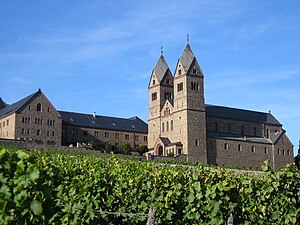Eibingen Abbey
| Eibingen Abbey Abtei St. Hildegard |
|
|---|---|
 |
|
| 49°59′33″N 7°55′41″E / 49.99250°N 7.92806°ECoordinates: 49°59′33″N 7°55′41″E / 49.99250°N 7.92806°E | |
| Location | Eibingen, Germany |
| Denomination | Catholic |
| Architecture | |
| Style | Romanesque revival |
| Groundbreaking | 1900s |
| Administration | |
| Diocese | Diocese of Limburg |
| Official name | Upper Middle Rhine Valley |
| Type | Cultural |
| Criteria | ii, iv, v |
| Designated | 2002 |
| Reference no. | 1066 |
| Region | Europe and North America |
Eibingen Abbey (German: Abtei St. Hildegard, full name: Benedictine Abbey of St. Hildegard) is a community of Benedictine nuns in Eibingen near Rüdesheim in Hesse, Germany. Founded by Hildegard of Bingen in 1165, it was dissolved in 1804, but restored, with new buildings, in 1904. The nuns produce wine and crafts. They can be heard singing their regular services, which were at times recorded. The church is also used as a concert venue. The abbey is a Rhine Gorge World Heritage Site.
The original community was founded in 1165 by Hildegard of Bingen. This was the second community founded by her. It was disestablished in 1804. After the Reichsdeputationshauptschluss (German mediatization), the land once owned by the convent became part of the domains of the prince of Nassau-Weilburg who, in 1831, even bought both the monastery and its church.
The community was reestablished by Charles, 6th Prince of Löwenstein-Wertheim-Rosenberg in 1904 and resettled from St. Gabriel's Abbey, Bertholdstein. The nunnery belongs to the Beuronese Congregation within the Benedictine Confederation. A new building was erected in Neo-Romanesque style. In 1941, the nuns were expelled by the Nazis; they were not able to return until 1945. In 1988, the sisters founded Marienrode Priory at Hildesheim, which became independent of Eibingen in 1998.
...
Wikipedia
